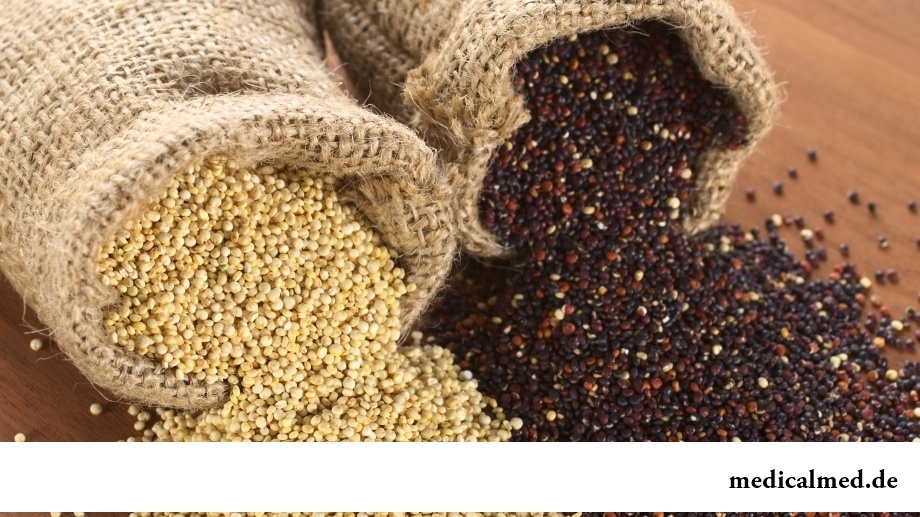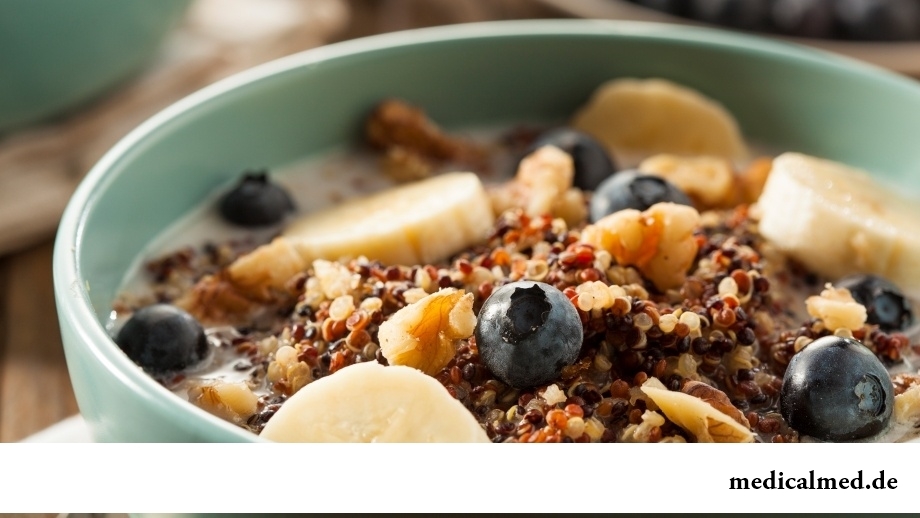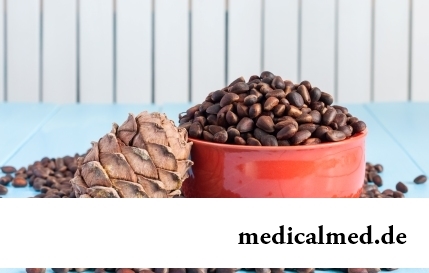





Kinoa
Description of a kino
The Kinoa belongs to grain one-year crops from family of the Goosefoot family growing in South America on slopes of the Andes. This rather high plant (reaching in height almost human height) with the light green stalk and roundish leaves similar to orach leaves. Grains by the form remind buckwheat of various color, and to taste – neoshelushenny rice. Depending on color of grains (beige, red or black) the kino is divided into three main types.

Titikak's coast, the biggest mountain lake on the planet, it is considered to be the homeland of a kino. This plant was cultivated for an appreciable length of time by inhabitants of valleys of hillsides (at the height of 3000-4000 m above sea level) where severe climatic conditions dominate.
Inca cultivated "Gold grain" on an equal basis with potatoes and corn. Such name was connected not only with the area height where grew up a kino, but with a set of useful properties of which ancient Inca knew. In lean years of a kino replaced with it rice, bread and potatoes.
After this plant began distribution on the world, it successfully got accustomed in Tibet, the Himalayas and other massif. Now the kino is also grown up on the sea coasts and on soils where earlier there was jungle.
The kinoa gained the recognition since the nineteenth century in Europe. In Russia it called an orach of a kino or an orach rice. After useful properties of this plant were open and studied, announced 2013 of UNESCO the International year of a kino.
Structure of a kino
In 100 g of a kino contains:
- 13,28 g of water;
- 14,12 g of proteins;
- 6,07 g of fats;
- 57,16 g of carbohydrates;
- 7 g of cellulose (food fibers);
- 2,38 g of ashes.
Among the vitamins which are a part of a kino, the leading place is taken by sincaline and ascorbic acid (70,2 and 6,8 mg in 100 g of grains respectively). Also it contains beta carotene, Riboflavinum, a pyridoxine, pantothenic acid, tocopherol and RR vitamin.
From macrocells most of all contains potassium and phosphorus (563 and 457 mg respectively), from microelements – iron and zinc (4,57 and 3,1 mg respectively).
Caloric content of 100 g of a kino makes 368 kcal.
Useful properties and advantage of a kino
According to nutritionists of a kino has no useful substances, equal among grain by quantity. In comparison with wheat, rice and barley in a kino more cellulose, alpha tocopherol, folic acid, Riboflavinum and complex carbohydrates contains.
Also many food specialists compare a kino to maternal milk as it is acquired by an organism almost completely. Besides, it treats one of the best sources of the vegetable whole protein necessary for athletes, children, pregnant women and vegetarians. According to representatives of the NASA agency of a kino is an ideal product for food of astronauts.
Represents undoubted advantage of a kino for allergic persons as gluten is not its part.
The Kinoa contains a lot of lysine which promotes digestion of calcium, bystry healing of fabrics, formation of bones, growth of hair, and also prevents development of anemia.
A large amount of cellulose, vitamins A, groups B, C and D and the tryptophane promoting synthesis of hormone of joy (serotonin) does useful a kino for those who have diabetes, a hypertension and various heart diseases.
The advantage of a kino as dietary product is also proved. The unique combination of a large amount of protein and amino acids to the minimum quantity of fat allows to apply it in a daily diet as the product promoting decrease in excessive weight.
Use and recipes of preparation of a kino
The Kinoa belongs to universal cereals – from it it is possible to make porridge, to make vegetable oil and salad of sprouts of germinated grain.
Three rules belong to the main secrets of the correct preparation of a kino:
- Grain needs to be washed out well that porridge did not taste bitter;
- The Kino should not be digested that grains did not become limp;
- After preparation porridge should be stirred carefully to avoid adhesion.

Porridge from a kino is perfectly combined with many products: mushrooms, raisin, dried cranberry, dried apricots, dates, paprika, carrot, parsley, cilantro, celery, fennel and dried apricots. Also it can replace rice in vegetable pilaf.
It is possible to bake not only bread, but also confectionery of the flour received from grains of a kino, for example, cookies with sesame. Also produce the pasta made of flour from a kino.
For preparation from a kino of the drink of grain of a plant which is perfectly satisfying thirst it is necessary to mix with sugar and to dilute with water.
Contraindications
The Kinoa has practically no contraindications except for cases of individual intolerance of this plant. The only caution of nutritionists care in reception of a kino by children and nursing mothers as their sensitivity to this plant is unknown is considered.
In our intestines are born, millions of bacteria live and die. They can be seen only at strong increase, but if they gathered, then would be located in a usual coffee cup.

Weakness of an ankle joint – very widespread problem. Its existence is demonstrated by tendency to a podvorachivaniye of legs п...
Section: Articles about health
The thought that the mass of their body is too big at least once in life visits from 80 to 95% of women. Many women are so obsessed with this idea that constantly try all new and new ways of weight reduction. Considerable part of these method...
Section: Articles about health
History of use of an anesthesia during operations contains more than 160 years. Annually in the world hundreds of thousands of surgical interventions during which to patients the substances immersing them in a dream and saving from pain are entered are carried out. Using an anesthesia many myths and delusions are still connected. It is worth getting acquainted with the most widespread of them....
Section: Articles about health
Each of us faces from time to time that other people need the immediate help. We react to it on-raznomu:...
Section: Articles about health
Run - one of the most available and effective ways to revitalize the organism. Knowing about its extraordinary advantage, each of us at least once tried to make jogs, but only the few made these occupations regular. In spite of the fact that in jogging (easy an ozdor...
Section: Articles about health
Very often as a source of the infection which caused a disease serves our house - the place which a priori has to be safe. However disease-producing bacteria can perfectly feel not only in insanitary conditions, but also in our apartment if not to carry out due care of favourite places of their dwelling. What they − sources of their reproduction? Let's consider 10 most widespread places in our house, the most dangerous from the point of view of infection with microorganisms....
Section: Articles about health
Heart disease and blood vessels lead to disturbance of blood supply of bodies and fabrics that involves failures in their works...
Section: Articles about health
Neurosis is called pathology of a nervous system at which deviations in functioning of the highest nervous processes are observed. Most often - owing to yet not strengthened mentality - children are subject to neurosises. Premises to emergence of such disturbances can become нез...
Section: Articles about health
It seems, quite recently you brought the baby from maternity hospital, but time flew by, and here it is already going to join the first in life children's collective. How to prepare the child for visit of a garden? What needs to teach him to facilitate adaptation process? What to tell and how to behave that the kid transferred changes in the life without serious consequences? Let's try to find answers to these questions....
Section: Articles about health
Zone hypostases under eyes - very widespread problem giving to people is a lot of inconvenience. Hypodermic fabric in these parts having...
Section: Articles about health
The summer of this year in Russia was very ambiguous. Regions suffered from a merciless heat, from pouring rains, the hail from time to time dropped out, then there was again a heat which alternated with rainfall again. Many people suffer from such sharp changes of weather...
Section: Articles about health
The hysteromyoma is diagnosed more than at a third of women 35 years are more senior. This high-quality new growth which at early stages successfully resolves by means of medicines. It is necessary to resort to an operative measure only when patients too late address specialists, or therapeutic methods do not give the expected effect because of specific features of an organism. Besides, there is a large number of quite effective national...
Section: Articles about health
Feeding by a breast - the integral part of ideal motherhood allowing to come into contact with the kid and to create since early years...
Section: Articles about health
Practice of use of table salt in the therapeutic purposes contains not one century. Applications which do by means of the fabric impregnated with saline solution are considered especially effective. They possess antibacterial and antiinflammatory эффек...
Section: Articles about health
Eyes – one of the most vulnerable areas on a face therefore age changes concern them first of all. Whether it is possible to keep look youth for many years and what procedures are offered for achievement of this purpose by cosmetologists? And maybe, the only option of rejuvenation is surgery – a blepharoplasty? Let's try to understand this question....
Section: Articles about health
Hemorrhoids – extremely widespread disease. Periodically arising inflammations and bleeding of hemorrhoidal nodes пр...
Section: Articles about health
Sugar - the digestible refined product which is not of special value for an organism of the modern person. The use of sugar in food is based rather on the psychological dependence caused by desire to indulge itself with something tasty, and in дальнейш...
Section: Articles about health
They say that to ensure health and longevity of people it is obliged. Really, at competent approach to these questions, minimization of an adverse effect of many factors does not represent a special problem. Practically everyone has an opportunity to play sports, to pick up an optimum operating mode and rest, to adjust healthy food, to refuse addictions. It is more difficult to exclude hit in an organism of harmful substances through a respiratory organs: not all are able to afford to live in the area with хо...
Section: Articles about health
Shops of household appliances offer us the huge choice of various devices for the house. Whether there are among this abundance devices which...
Section: Articles about health
During foot walks blood moves on vessels more actively and one and all bodies are supplied with a large amount of oxygen. It affects the state of health of the person very positively....
Section: Slideshow
The state of health of the person depends on many factors. One of the most important is the constant, but not exhausting a physical activity. In the presence of various illnesses specialists often advise patients to do swimming which by right takes the leading place by efficiency of improvement, having at the same time a few contraindications. Today we will talk about the main directions of therapeutic impact of swimming on a human body....
Section: Articles about health
The technique of acupuncture (acupuncture) is used in the medical purposes more than three and a half millennia. It widely races...
Section: Articles about health
You heard that laughter prolongs life? Researchers did not manage to establish longevity direct link with sincere fun yet, but several facts confirming beneficial influence of risibility on the state of health are clinically proved....
Section: Articles about health
The brain of the person is studied not one hundred years, but the quantity of the riddles connected with this body increases rather, than decreases. Perhaps, numerous delusions concerning a structure and functioning of a brain are explained by it, many of which arose long ago, but continue to exist and today. Such we are ready to acquaint readers with the most widespread myths....
Section: Articles about health
Condition of lips (their morbidity, outward) – one of indicators of health of the person. Peeling, dryness, pallor, and also трещ...
Section: Articles about health
One of the major chemical processes happening in a human body are oxidation reactions. They go with participation of fats and carbohydrates which we receive from food, and the oxygen getting to us from air. A main goal of such reactions is it is received...
Section: Articles about health
Not everyone can brag of the shining Hollywood smile. Even the person who is regularly visiting the stomatologist and watching of oral cavities over health periodically has problems: enamel of teeth darkens under the influence of some products, on it the deposits giving to teeth a grayish or yellowish shade collect....
Section: Articles about health
